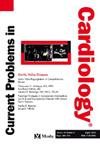Incidence and outcomes of acute myocardial infarction with arrhythmic onset: A retrospective cohort study
IF 3.3
3区 医学
Q2 CARDIAC & CARDIOVASCULAR SYSTEMS
引用次数: 0
Abstract
Introduction
Patients with acute coronary syndrome (ACS) have concomitant ventricular arrhythmic events (VA). Literature data are conflicting regarding short- and long-term prognosis. International guidelines do not recommend defibrillator (ICD) implantation in the first 40 days after a myocardial infarction. However, some patients may have an increased arrhythmic risk and deserve closer monitoring.
Purpose
The aim of our study was to define the incidence of arrhythmic events in a population of patients admitted for ACS to the Cardiac Intensive Care Unit (CICU) of a tertiary center and to determine the short- and long-term prognosis in patients with arrhythmic onset compared with patients without arrhythmic onset.
Methods
This is a single-center retrospective cohort data analysis of 1587 consecutive patients admitted with a diagnosis of ACS to the CICU of Niguarda Hospital of Milan, from 2014 to 2022. We classified the patients into two groups according to the arrhythmias at presentation: VA (sustained VT or VF) and no-VA. Kaplan–Meier (KM) estimated the probability of remaining event free in the time after ACS and were compared between VA and no-VA groups, using the log-rank test. Cox regression analysis was used to explore the association of specific variables with the occurrence of cardiac events in univariate and multivariate analysis. Statistical analyses were performed with R 42.0 statistical package (R Core Team, Vienna, Austria).
Results
Among 1587 ASC patients, 4.6 % had arrhythmic onset (4.0 had a diagnosis of VF and 0.6 % of VT). Patients with VA were significantly younger (63 y. vs 67 y., p = 0.026) and had a lower incidence of cardiovascular risk factors, such as hypertension and dyslipidemia, compared with no-VA group. VA group had a higher risk of arrhythmias during the hospitalization (9.6 % vs 1.3 %, p < 0.001) and had a clinical course characterized by a significantly higher use of mechanical support with intra-aortic balloon pumps (IABP, 35.6 % vs. 6.8 %, p < 0.001) and a greater use of inotropic drugs (34 % vs. 9 %, p < 0.001). We observed in VA group a six-fold increase in-hospital mortality (23 % vs 4 %, p < 0.001), identifying arrhythmic presentation as a marker of worse in-hospital prognosis in patients admitted with ACS. Likewise, mortality at 40 days after the acute event was higher in the VA group than in the no-VA group (22 % vs. 5 %, p < 0.001). Conversely, during a median follow-up of 5.9 years, VA onset did not affect long-term mortality in patients discharged alive.
Conclusion
In this long-term follow-up retrospective registry involving a large cohort of patients with ACS admitted to the CICU, concomitant VA at admission was found to be linked with an increase in in-hospital arrhythmic complications and in-hospital mortality. The mortality rate at 40 days post-ACS was also notably higher in the VA group. This study underscores the complexity of arrhythmic presentation in ACS patients, emphasizing the critical need for vigilant monitoring throughout their hospitalization and particularly in the initial 6 weeks following the event index. This heightened surveillance is justified by the documented elevated levels of morbidity and mortality during this phase.
心律失常起病的急性心肌梗死的发病率和结局:一项回顾性队列研究。
简介:急性冠脉综合征(ACS)患者伴有室性心律失常事件(VA)。文献资料在短期和长期预后方面存在矛盾。国际指南不建议在心肌梗死后的头40天内植入除颤器。然而,一些患者可能会增加心律失常的风险,需要更密切的监测。目的:本研究的目的是确定三级中心心脏重症监护病房(CICU)收治的ACS患者群体中心律失常事件的发生率,并确定心律失常发作患者与无心律失常发作患者的短期和长期预后。方法:采用单中心回顾性队列数据分析,纳入2014年至2022年米兰尼瓜达医院CICU确诊为ACS的1587例连续患者。我们根据心律失常的表现将患者分为两组:持续性室性心动过速(VA)和无室性心动过速(VF)。Kaplan-Meier (KM)估计ACS后剩余事件自由的概率,并使用log-rank检验比较VA组和无VA组之间的差异。在单因素和多因素分析中,采用Cox回归分析探讨特定变量与心脏事件发生的关系。采用R 42.0统计软件包(R Core Team, Vienna, Austria)进行统计分析。结果:1587例ASC患者中,4.6%为心律失常起病(4.0%诊断为室性心动过速,0.6%诊断为室性心动过速)。与无VA组相比,VA患者明显更年轻(63岁vs 67岁,p =0.026),高血压和血脂异常等心血管危险因素的发生率也更低。VA组在住院期间发生心律失常的风险较高(9.6% vs 1.3%, p< 0.001),其临床病程以主动脉内球囊泵机械支持的使用显著增加为特征(IABP, 35.6% vs 6.8%, p)。在这项长期随访的回顾性登记研究中,纳入了大量入住CICU的ACS患者,发现入院时合并的VA与院内心律失常并发症和院内死亡率的增加有关。在acs后40天,VA组的死亡率也明显更高。本研究强调了ACS患者心律失常表现的复杂性,强调了在整个住院期间警惕监测的关键必要性,特别是在事件指数后的最初6周。这一阶段记录的发病率和死亡率升高证明加强监测是合理的。
本文章由计算机程序翻译,如有差异,请以英文原文为准。
求助全文
约1分钟内获得全文
求助全文
来源期刊

Current Problems in Cardiology
医学-心血管系统
CiteScore
4.80
自引率
2.40%
发文量
392
审稿时长
6 days
期刊介绍:
Under the editorial leadership of noted cardiologist Dr. Hector O. Ventura, Current Problems in Cardiology provides focused, comprehensive coverage of important clinical topics in cardiology. Each monthly issues, addresses a selected clinical problem or condition, including pathophysiology, invasive and noninvasive diagnosis, drug therapy, surgical management, and rehabilitation; or explores the clinical applications of a diagnostic modality or a particular category of drugs. Critical commentary from the distinguished editorial board accompanies each monograph, providing readers with additional insights. An extensive bibliography in each issue saves hours of library research.
 求助内容:
求助内容: 应助结果提醒方式:
应助结果提醒方式:


